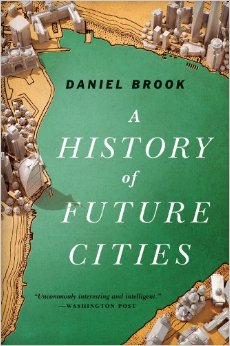
A History of Future Cities
Daniel Brook
457 pages including index
published in 2013
I took the title more literally than it was intended when I took it out of the library, thinking this was some sort of futuristic look at how cities were likely to evolve in the twentyfirst century and beyond. Instead it turned out to be a cultural history and comparison between four cities explicitly founded and developed to provide a vision of the future for their respective countries: St. Petersburg, Shanghai, Bombay/Mumbai and Dubai. This looked just as interesting so I kept reading despite the initial disappointment.
The problems with any comparative history book like this is that it's easy to get lost in the historical narrative of each city and to a certain extent this happened here, as Brook tells the story of each of these four cities in a chronological order, with most chapters focusing on a single city. There is however a certain theme to these stories, one that tells of how modernity is introduced by authoritarian regimes of one stripe or another with the intention to limit its reach to those sectors of society it thinks needs modernising, only to have the city's influence reach beyond it, for which it is punished, only to ultimately triumph. It's a very western, neoliberal view of the world, as culminating in the slightly sycophantic look at Dubai.
So, to recap: St. Petersburg was born out of the desire of czar Peter to make Russia into a modern, European military power, deliberately emulating the city of Amsterdam, populated with imported crafts people from Holland and other western European countries. With them and the ideas they brought also came unwelcome imports about things like how serfdom isn't cool and czarism a drag, which were harshly surpressed but never quite disappeared. As czarist Russia became the stalinist USSR, now Leningrad was downgraded because the totalitarian rulers could never quite trust it.
Meanwhile, Bombay/Mumbai and later Shanghai were cities created out of a coloniser's need for trade ports, with the British ruling India directly while Shanghai was created into an international free city open to all Europeans but not so much Chinese. In both cases, the cities evolved into a modern, mixed population metropolis of great economic importance, but their respective roles during their countries' colonial eras meant that those too were shackled by India and China's new rulers, their values incompatible with those in favour in the rest of the country.
Dubai meanwhile is the post-modern equivalent of these cities, an attempt to emulate them and provide its country with a modern financial and business capital that can maintain its value long after Dubai's relatively modest oil wealth would run out. The youngest of the four, it's also the city Brook pays the least attention to.
Brook sees all four cities as sort of precursors for the modern, cosmopolitan, globalised twentyfirst century world, which he largely sees as positive. And to be honest, there is much to be admired in those cities, even a city like Shanghai, which I'd always seen as the quintessential example of western arrogance with regards to China, had its good side. It would actually make for a great model to nick for a space opera setting. A breezy read, as long as you don't take everything Brook tells you as gospel, this is interesting enough to take a punt on.
Webpage created 05-02-2015, last updated 23-03-2015.